In June I got a call asking if I was available to teach photography on an Arctic cruise in July. And since I’d already be there, could I stay and do a second cruise? While my calendar’s been pretty full this year, July was the one month that was wide open. So, after getting permission from my long-suffering wife, I said yes. It turned out to be a great experience.
As a history buff, and fan of adventure stories, I’ve read plenty about the Arctic. In fact, earlier this year I read “In the Kingdom of Ice,” about a U.S. expedition to the Arctic in the late 1900s. Few of those stories end well. It’s a barren land of extreme weather. For the early explorers, which means any time more than 100 years ago, being trapped in the ice and gone for over a year were the norm.
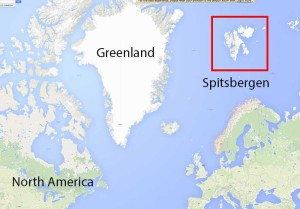
North of Norway and east of Greenland, Spitsbergen is a popular location to explore the land, water and wildlife of the Arctic.
Today it’s quite different. Most Arctic trips focus on Spitsbergen (also called Svalbard), an archipelago of islands north of Norway. You go to Oslo, then take a flight to Longyearbyen, the largest town in the archipelago. Once there you board one of the small cruise ships that carry from a few-dozen to around a hundred passengers.
This wasn’t my first time teaching photography on a ship. About ten years ago I taught a few workshops on cruise ships, and didn’t like it. You spend too much time on the ship, and too little time – at the wrong time of day (mid-day) – on shore. Back then I said I’d only do it again with a smaller ship and more time off the ship. And that’s just what this was.
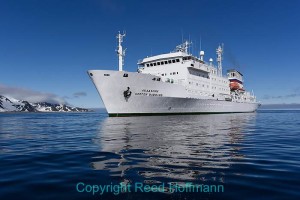
My home for three weeks in July, the “Akademik Sergey Vavilov.”
Nikon D750, Aperture Priority, ISO 200, 1/1600 at f/8, 18-35mm Nikon f/3.5-4.5 lens at 26mm. Photo copyright Reed Hoffmann.
My home for most of July was a Russian ship, the Vavilov, built in the late 1980s as a research vessel. Because of that, the ship was built to go into ice, and has an impressive auto-stabilization system. Add to that its moderate size and bow and stern thrusters, and it becomes a great photo platform. One Ocean Expeditions leases it for Arctic and Antarctic trips, and it can house up to about 90 passengers. As a photographer, though, the best part is that it carries ten Zodiacs – small inflatable boats – making it easy to get away from the ship.
I’ve been teaching workshops for fifteen years now, so I’m used to being an instructor. In this case, though, I was also “staff” on the ship. Which meant added responsibilities. Exciting stuff like helping with luggage. But that was okay, because the whole staff vibe was sort of like the Three Musketeers – “all for one and one for all.” Everyone working on the ship was fun, smart and talented, and pitched in on whatever needed to be done. So it was a bit like college life again. We shared rooms, shared bathrooms and shared the work-load.
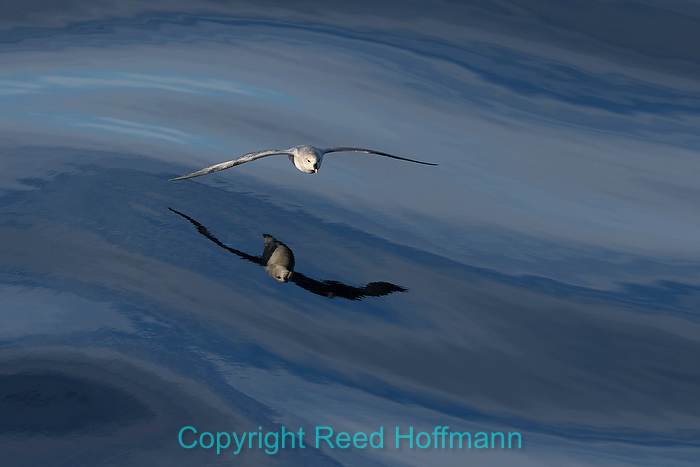
It’s hard to force yourself to go to bed at night with things like this happening. I shot this Fulmar from the deck of the ship a little after 11pm. Nikon D7200, Aperture Priority, ISO 400, 1/2000 at f/6.3, EV -1.0, 500mm f/4 Nikon lens at 500mm. Photo copyright Reed Hoffmann.
The strangest part of the whole experience, though, was the endless daylight. At that time, in that part of the world, the sun never sets. Well, at least not until later in August. For a photographer, that’s both a good AND a bad thing. On most trips, when it gets dark, that’s our sign to relax, recharge and rest. But since the sun never set, the tendency was to stay up late. Too late. You’d be in the upper lounge after dinner and think, “Gee, it must be about 8:30.” No. More like 11:30. And even worse, that’s when the sun would get low on the horizon, which of course meant even better light because of the low angle. I did NOT get much sleep! But I did get some nice photos. And there were lots of opportunities for that. For while there nice pictures to be made from the deck of the ship, we had those Zodiacs too.
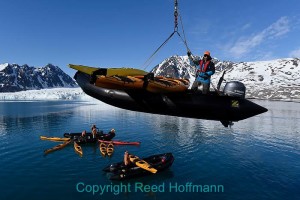
The Zodiacs, along with their drivers, and sometime sea kayaks, are launched by a crane on the ship. Nikon D750, Aperture Priority, ISO 125, 1/1000 at f/7.1, EV -0.3, 18-35mm Nikon f/3.5-4.5 lens at 23mm. Photo copyright Reed Hoffmann.
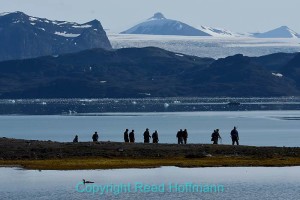
One of the hiking groups follows the shore while enjoying the views and looking for wildlife. Nikon D7200, Aperture Priority, ISO 125, 1/640 at f/10, EV -1.3, 80-400mm f/4.5-5.6 Nikon lens at 165mm. Photo copyright Reed Hoffmann.
Our days usually included two, and sometimes even three excursions on the Zodiacs. If you’re not familiar with them, think a small boat with a pointy bow and metal floor (dry), but the sides are large (inflated) rubber tubes. They pull up next to the ship, you go down a set of stairs, step in and then sit on those tubes. A guide drives the boat with a 60hp outboard motor. One of the many advantages of zodiacs are that they can go almost anyplace there’s water. So our excursions could be either “landings” or “cruises.”
“Landings” were, well, where we’d land on shore and take hikes. Those outings would be to see either historic sites (old camps and such) and/or wildlife (mostly birds or reindeer). Going on land in the Arctic, though, poses one big danger – polar bears. There’s just one animal on earth that will actively track and hunt humans. Want to guess which one? So anytime we had a shore excursion planned, a group of guides, with firearms, would go first to scout for polar bears. Once we got the all-clear (and there was one time we didn’t), we’d land. After that we’d usually split into three groups. “Chargers” were for those who wanted to go fast and cover a lot of ground. Not a good choice for photographers. “Long and Slow” were for those who wanted to cover ground, but also take time to explore and take pictures. And then there was always either a short hike or a “Contemplative” group, who’d stay near the shore and do a relaxing, easy walk. Or maybe even take a Zodiac cruise along the shore. The goal was to make sure that everyone who wanted to do an excursion could, at the level they were comfortable with.
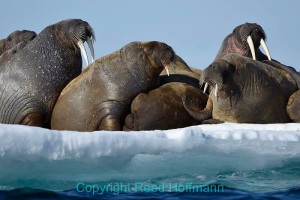
Oh yeah, there were walruses too. We were able to visit a couple of colonies of males, photographing them both from land as well as from the water (like this). Nikon D7200, Aperture Priority, ISO 200, 1/1600 at f/7.1, EV -1.0, 80-400mm Nikon f/4.5-5.6 lens at 400mm. Photo copyright Reed Hoffmann.
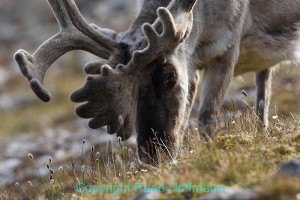
On the first trip the reindeer looked pretty ragged, as they were losing their winter coats. Later in the second trip, though, most of that hair was gone, leaving them sleek and pretty. Nikon D7200, Aperture Priority, ISO 250, 1/500 at f/8, EV -0.7, 500mm f/4 Nikon lens with TC-20EII teleconverter for 700mm. Photo copyright Reed Hoffmann.
“Cruises” with the Zodiacs, on the other hand, were where we’d stay in the boats, and either follow the shore or weave through icebergs to view glaciers. I’m a big fan of Zodiacs now, because as a photographer, getting close to subjects is important. We not only photographed icebergs, we were so close at times we could touch them. And if you want to shoot birds that nest on seaside cliffs, being on the water makes that much easier. Of course, being right under the cliffs that tens of thousands of bird are flying in and out of presents other problems. Stuff that rains down on you occasionally. Yes, that’s right, you know what I’m talking about. You keep your mouth closed when looking up, and wear a hat. But wow, the access we had! I’m not a birder, but on this trip, I may have become one, in a small way.
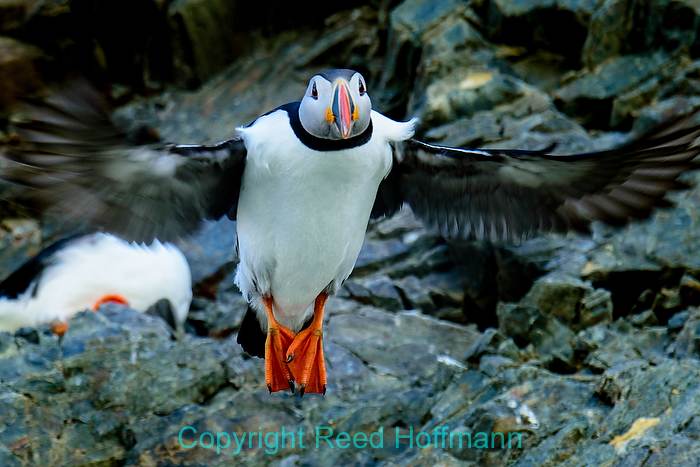
Yes, there are puffins there, and yes, they’re just as adorable in real life as in pictures. Nikon D7200, Aperture Priority, ISO 400, 1/500 at f/5.6, EV -0.7, 80-400mm Nikon f/4.5-5.6 lens at 350mm. Photo copyright Reed Hoffmann.
The weather, while summer, is fairly cold. Mostly 30s and 40s, occasionally below freezing. It helps that the ship supplies everyone with “wetskins” and rubber boots. Wetskins are waterproof bib overalls and jackets, and the boots are because sometimes you have to wade to/from the boats, and where you walk can be muddy.
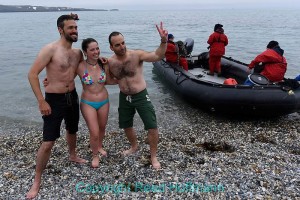
Some people were crazy enough to go swimming, though not for long. Note how the folks in the Zodiac are dressed. I of course, went in. Twice. Nikon D750, Aperture Priority, ISO 160, 1/320 at f/6.3, 18-35mm Nikon f/3.5-4.5 lens at 23mm. Photo copyright Reed Hoffmann.
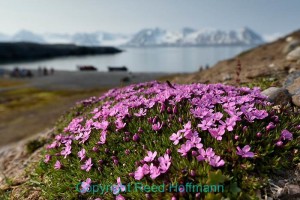
There’s not a lot of growth there, between the short season and the cold. But those tiny flowers sure were pretty! Nikon D750, Aperture Priority, ISO 160, 1/125 at f/11, EV -0.3, 18-35mm f/3.5-5.6 Nikon lens at 28mm. Photo copyright Reed Hoffmann.
So how does all this work, being a photographer? I brought two cameras, a Nikon D750 and Nikon D7200. That gives me both a full-frame camera (D750, FX) and a crop-frame camera (D7200, DX). I like that combination, as my telephotos lenses essentially have more “reach” on the DX body. For lenses I brought along an 18-35 f/3.5-4.5, 50mm f/1.8, 80-400mm f/4.5-5.6 and 500mm f/4. Also a 2X teleconverter (TC-20E III) and small flash (SB-500). The 18-35 and 80-400’s were my workhorse lenses, what I shot with most of the time. When I went into a Zodiac, it was usually with those two, often in a small drybag backpack to protect them from any salt spray.
While most of the time the seas were relatively calm, it can still be a challenge to shoot from a small boat. That’s one reason I used the 80-400 so much. It has VR (Vibration Reduction), and the ability to switch that to “Active” mode. “Normal” mode helps reduce camera shake from holding the camera, while “Active” is for when you’re on a moving object (like a boat). Having that great zoom range, from 80-400, let me frame looser when the boat was bouncing, tighter when it wasn’t. And when we were near glaciers, I could lean out of the boat with the 18-35 and get within a foot of the small icebergs. Which was great.
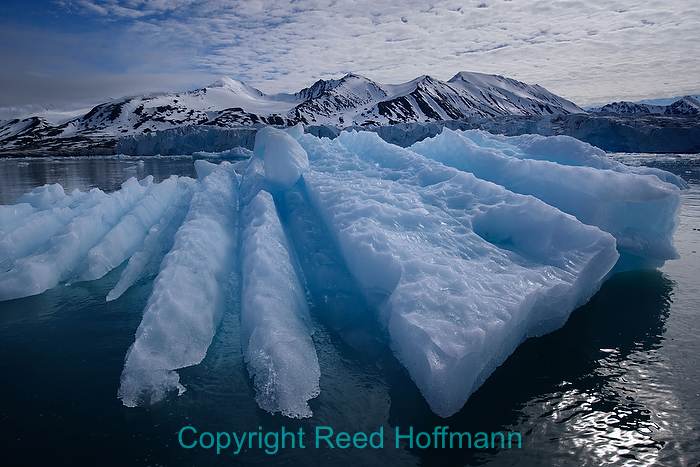
Did I mention that being in the Zodiacs we could get close to the ice? If they were small, we could pull right up to them, and for me that was a great opportunity to build a photo with both a nice foreground and background. Nikon D750, Aperture Priority, ISO 125, 1/800 at f/11, EV -0.7, 18-35mm Nikon f/3.5-4.5 lens at 24mm. Photo copyright Reed Hoffmann.
So why bring the 500mm lens? For polar bears. One of the big draws to an Arctic trip is the possibility of seeing polar bears. They spend a great deal of time hunting seals, and that’s best done on the ice. So to hunt polar bears, the ship skirts the edge of the pack ice, with people using binoculars and spotting scopes to try and find them. Some of the staff excel at this. They say if you’re looking for a “pat of butter.” Spot one and it may be a polar bear. Or a bit of dirty ice. Generally the sightings are a mile or two away, with the bear asleep. When one’s been spotted, and confirmed, there’s a PA announcement and all other activity (like presentations on photography) stops. That’s when things get really interesting. Because now a big ship full of people is going to try to sneak up on a polar bear.
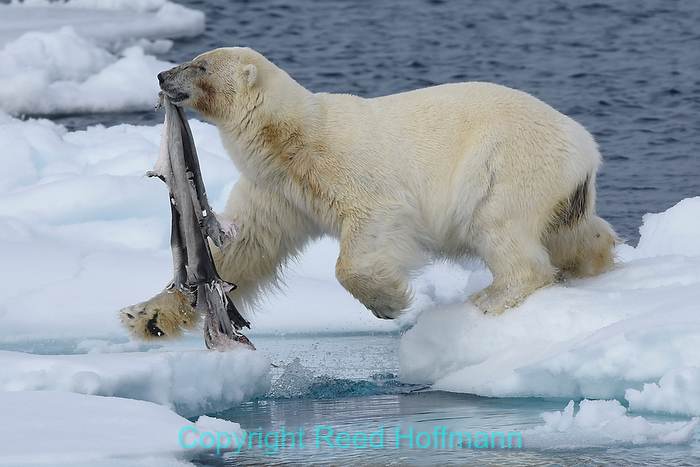
This bear was like a dog with a bone, running away with its seal skin every time we approached. Eventually we left it alone and moved on to find other bears. Nikon D7200, Aperture Priority, ISO 250, 1/2000 at f/6.3, EV -0.3, 500mm Nikon f/4 lens with TC-14E II teleconverter for 700mm focal length. Photo copyright Reed Hoffmann.
Remember earlier when I mentioned the ship was built for ice, and had bow and stern thrusters? Those two things are the keys to getting close to polar bears. With the bear spotted, the ship slows down, and starts nudging its way into the ice. Moving solely with those thrusters, it may take two hours to slowly creep up on the bear. At some point the bear will wake up and notice you, and either decide to stick around or leave. If it leaves, the ship will try to follow for a while. But if it’s obvious the bear wants to be left alone, then we leave it alone. On both trips we had good bear sightings. Sometimes they stayed, and we got very close, other times they left. One time we found a curious bear, who twice walked right up to the ship to check us out. Another time we had a young bear who was intent on eating a seal, and couldn’t have cared less that we pulled up within 50-yards of it. Pretty amazing. And at those times, I used everything from the 500mm with 2X extender (on a tripod) down to the 18-35 (to show the smallness of the bear in a world of ice).
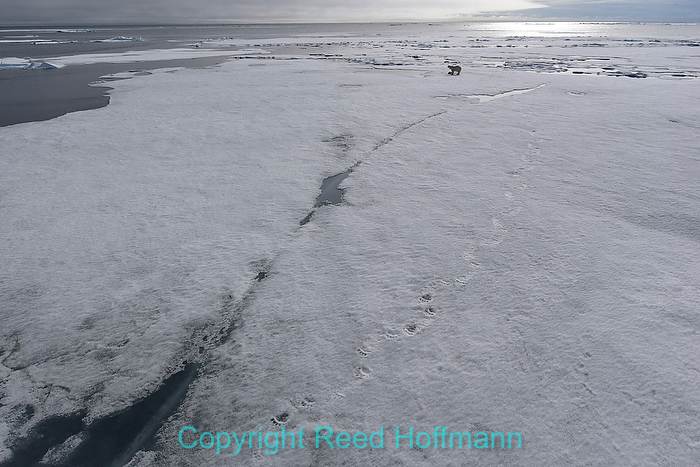
Occasionally I’d use the wide-angle lens to show the vastness of the sea and ice. In this case, you can follow the bear’s footprints in the snow right out to where he’s standing. Nikon D750, Aperture Priority, ISO 100, 1/500 at f/11, 18-35mm f/3.5-4.5 lens at 22mm. Photo copyright Reed Hoffmann.
Life on the ship was fun, and a bit like the movie “Groundhog Day.” Every day was the same routine. Breakfast (good food, by the way), then an outing. Return, have lunch, followed by another outing. Then dinner, and usually talks, or perhaps an outing, before meeting in the lounge up top for a drink and to enjoy the views. Then late to bed, and repeat again the next day. The first trip was eleven days, the second ten. And that length was about right to see and do a lot, and really disconnect from my “real” life. And disconnected you were. No cell service, no internet. You could make satellite calls (for a fee), and get a shipboard email account (text only, no photos, no web surfing). But that was fine too. Having email meant I could stay in touch with family and work, without the extra distractions of the web and phone. I enjoy unplugging sometimes.
And on this trip, I began to understand the draw of the Arctic. Why people kept pushing up there, exploring and sometimes dying. It’s beautiful. The landscapes, the wildlife, the ice. Severe, but inspiring. And one thing I heard over and over, from both staff and some of the passengers, was, “if you like this, you’ll love the Antarctic.” I can’t wait to find out.
(One Ocean Expeditions, a Canadian company, is who leases the Vavlilov, and its sister ship, the Ioffe, for these expeditions. I’ll be back on the Vavilov, this time in the Antarctic, in January of 2017, teaching a small photo workshop for Pack Paddle Ski. If you’re interested in joining me, there are a few spots left. Go here for details).
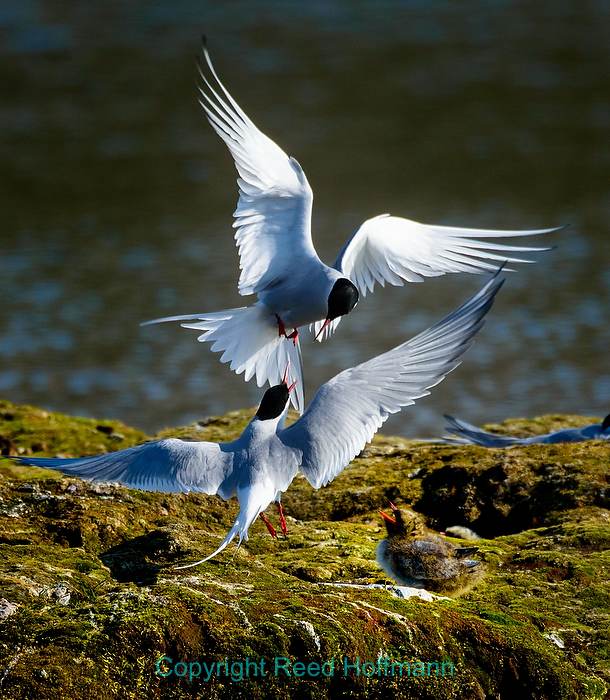
The Arctic Terns were one of my favorite birds, true acrobats in the air. In this case a male is returning to the nesting area where the female and a chick greet him. Nikon D7200, Aperture Priority, ISO 400, 1/2000 at f/6.3, EV -1.0, 80-400mm Nikon f/4.5-5.6 lens at 400mm. Photo copyright Reed Hoffmann.

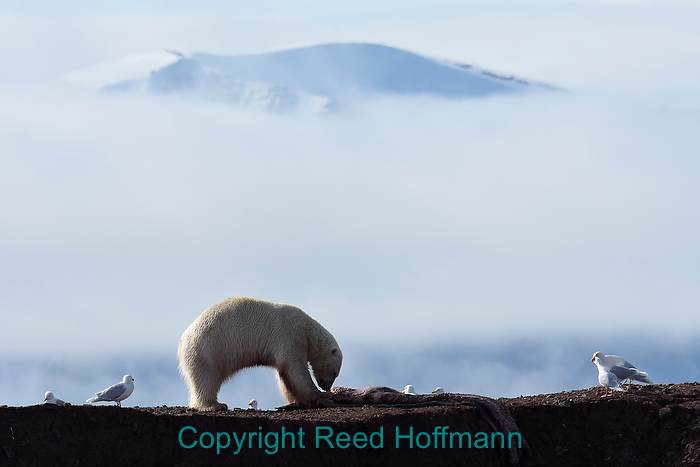
Trackbacks/Pingbacks